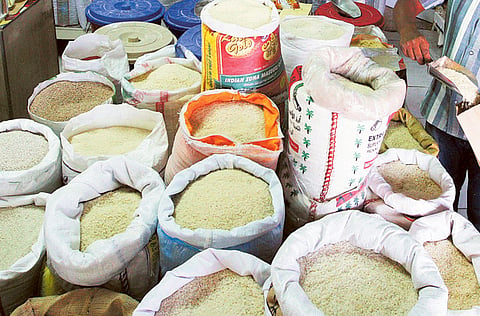UAE among world's biggest rice consumers
UAE’s per capita rice consumption per year is one of the highest in the world

Dubai: Rice seems to be the favourite food staple for the majority of people living in the UAE as, according to a new report, the country is one of the highest per capita consumers of rice in the world.
According to statistics released by Dubai Customs, 772 million kilos of rice was imported in the UAE in 2013, out of which 98 million kilos was re-exported. These figures suggest that 673 million kilos of rice worth Dh2.1 billion was consumed locally, amounting to 70kg to 80kg of rice per capita per year.
The consumption has increased from 2012, when 575 million kilos was consumed compared with 673 million kilos in 2013.
The UAE’s average annual per capita consumption is well above the global average of 64kg.
The daily average per capita consumption of rice is also higher at 220g, which is equivalent to around three plates of rice per day.
A high density of Asian population in the UAE, including Indians, Bangladeshis and Filipinos, whose staple diet is rice, could be one of the reasons for the UAE’s high consumption.
Speaking to Gulf News, expert economist Professor Cedwyn Fernandes said rice is considered an inferior good from an income elasticity perspective, with studies suggesting that as incomes increase, rice consumption falls as people can now afford to switch to high-value products such as meat, dairy products, fruits, and vegetables.
“The disproportionate high per capita consumption of rice in the UAE could be due to the skewed income distribution. While the overall per capita income of the UAE is high and would put it in the developed countries bracket, its per capita consumption of rice is more towards that of a developing country,” said Prof Fernandes, CEO of Institute of Management Technologies, Dubai.
"The reason for this is that a substantial proportion of the population is expatriate labour contracted at low wages. Many of these labourers are provided food in the camps by their sponsor and rice is the cheapest staple food."
Availibility of a wide variety of rice, its affordability and durability are also among the reasons for its popularity.
He added that rice-based dishes are the cheapest filling meal that can be purchased at lower-end restaurants catering to this segment of the population. This leads to the disproportionate mis-match between the per capita income and the per capita rice consumption.
But, interestingly, Emiratis and other Arab nationals are also regular rice eaters with biryani, mandi and madhbi being popular rice-based dishes.
However, experts suggest that a high percentage of the rice is not actually consumed, but is wasted.
Interestingly, the UAE is on a par with India for per capita consumption, which is one of the highest producers and consumers of rice in the world.
Topping the consumption list is Vietnam, which consumes 217.4kg of rice per capita per year. Among the top consumers are Bangladesh, Myanmar, Thailand, Indonesia, Malaysia, Philippines and China.
Sign up for the Daily Briefing
Get the latest news and updates straight to your inbox



